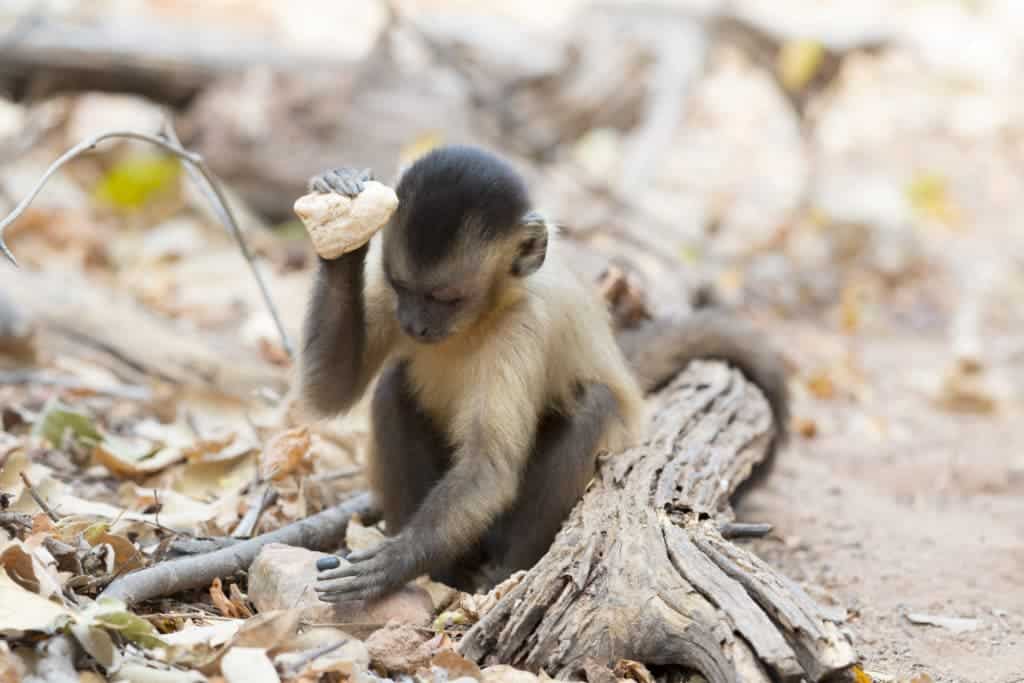
Somewhere in Brazil’s remote Serra da Capivara National Park, stone tool technology has been refined and perfected for more than 3,000 years — but not by some tribe of humans. According to a 2019 study, bearded capuchin monkeys have been consistently using quartz stones to crack open cashew nuts, making the site the oldest non-human archaeological site in the world.
Since the past century, scientists have been aware that tool use is not an exclusively human trait. Many primates, for instance, use food-obtaining tools derived from sticks, which they employ in various creative ways. Chimps have been observed using sticks to smash fruit and some chimps have even been seen hunting bush babies with primitive spears that they thrust into the animal’s sleeping hollow. Some primates collect honey with sticks. Sumatran orangutans alone use up to 54 types of tools for extracting insects or honey.
Archaeological evidence suggests that chimpanzees in Côte d’Ivoire have been using stone tools to gain access to food for over 4,000 years. While not as old, recent digs in Brazil show that capuchin communities have adapted their tools over time. Researchers described over 122 capuchin stone artifacts of varying sizes and hardness — which cater to different types of foods — created over the course of 450 generations.
In other words, the capuchins in Serra da Capivara have their own archaeological record which traces back their antiquity. So, this is yet another trait that we’ve found is not unique to humans.
Understanding how capuchins have evolved in their tool use may reveal how other primates originally develop their own tool use, including our ancestors. Some of the oldest tools — deliberately flaked off rock projectiles and cutting tools — on the record are 3.3 million years old and are attributed to Australopithecus afarensis or Kenyanthropus platyops, two human ancestors. But before early human ancestors started to shape their own tools, scholars believe that they first used unmodified stone cobbles to process food, much like the capuchin in Brazil.
The oldest tools found at the site are relatively small and lightweight. Although these stones sustained a lot of damage from all the bashing, they did not exhibit any cashew stains (as seen today). But, something radically changed around 560 years or so ago, when the capuchin started wielding larger stones, implying they were going after harder foods. Finally, in the last 300 years, the capuchins have settled into an intermediate tool size and shape that is consistent with their current strategy of bashing cashew husks. This is evidenced by the telltale pockmarks on the rocks, stained brown from the cashew husks.
“We identify monkey stone tools between 2,400 and 3,000 years old and, on the basis of metric and damage patterns, demonstrate that capuchin food processing changed between ~2,400 and 300 years ago, and between ~100 years ago and the present day. We present the first example of long-term tool-use variation outside of the human lineage, and discuss possible mechanisms of extended behavioural change,” the authors concluded.
In other words, the tool use morphed to satisfy the capuchin’s diet. The researchers aren’t sure why their diet changed, but it could be that different groups of capuchin acquired a different taste for other foods. Alternatively, different plant foods appeared and disappeared in their area.
It’s quite remarkable to think about the fact that a non-human species is now fully in the Stone Age. Whether the capuchins can ever move into a more advanced stage of tool use is anyone’s guess at this point.
The findings appeared in the journal Nature Ecology & Evolution.


